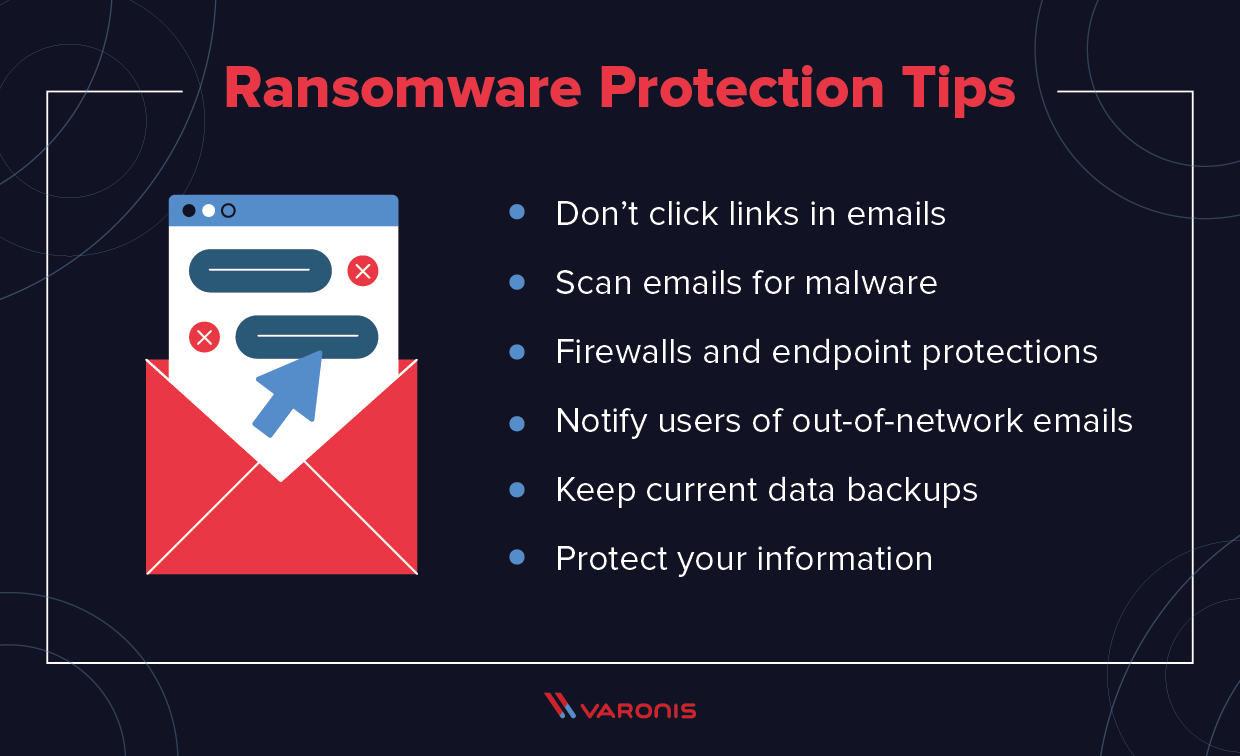How can ransomware attacks be prevented?
How can ransomware be prevented?
Effective ransomware prevention requires a combination of good monitoring applications, frequent file backups, anti-malware software, and user training. Although no cyber-defenses reduce risk completely, you can greatly limit the chance attackers will be successful.
Are ransomware attacks preventable?
Ransomware is a significant security threat to any organization, but it’s entirely preventable. Taking action to minimize the probability of infection and ensuring that clean backups are available for system restoration can dramatically decrease the cost associated with a ransomware attack.
What is the most common solution to a ransomware attack?
Best Solutions to Put in Place to Stop Ransomware Attacks:
- Antivirus and anti-malware
- Backup and file management
- Employee training
- Multi-factor authentication
- Policy of least privilege
- Ransomware detection
- Software updates and patch management
- Strong passwords
What is ransomware and how do you protect?
Ransomware is a type of malware which prevents you from accessing your device and the data stored on it, usually by encrypting your files. A criminal group will then demand a ransom in exchange for decryption. The computer itself may become locked, or the data on it might be encrypted, stolen or deleted.
What are the top 3 causes of successful ransomware attacks?
Ransomware attack vectors and mitigations:
- Phishing
- Remote Desktop Protocol (RDP) and credential abuse
- Vulnerabilities
What technology stops ransomware?
Mimecast provides a multi-layered approach to anti-ransomware technology and email security. Using state-of-the-art detection engines and sophisticated threat intelligence, Mimecast not only helps to protect from ransomware but to stop phishing, spear-phishing, CEO fraud, data leaks and other threats.
Why is ransomware hard to prevent?
Ransomware is an evolving threat—attackers are always searching for more advanced ways to carry out their plans. Cybercriminals utilize various attack vectors to distribute malware infections. That’s why it’s so hard for organizations to find single protection against ransomware attacks.
What is the #1 cause of ransomware?
Infection Vectors:
The majority of ransomware is propagated through user-initiated actions such as clicking on a malicious link in a spam e-mail or visiting a malicious or compromised website.
What is the most common cause of ransomware?
Ransomware is often spread through phishing emails that contain malicious attachments or through drive-by downloading. Drive-by downloading occurs when a user unknowingly visits an infected website and then malware is downloaded and installed without the user’s knowledge.
Why can’t ransomware be stopped?
Today’s ransomware and malware are sophisticated, using random extensions and file names, which makes detection by signature-based (blocked list) solutions ineffective. Cloud Secure uses advanced machine learning algorithms to uncover unusual data activity and detect a potential attack.
Who is most affected by ransomware?
Ransomware can affect anyone who uses a computer or a device connected to the internet. Organizations of all sizes, as well as individuals, can fall victim to ransomware attacks.

How can ransomware be prevented
Effective ransomware prevention requires a combination of good monitoring applications, frequent file backups, anti-malware software, and user training. Although no cyber-defenses reduce risk completely, you can greatly limit the chance attackers will be successful.
Are ransomware attacks preventable
Ransomware is a significant security threat to any organization, but it's entirely preventable. Taking action to minimize the probability of infection and ensuring that clean backups are available for system restoration can dramatically decrease the cost associated with a ransomware attack.
What is the most common solution to a ransomware attack
Best Solutions to Put in Place to Stop Ransomware AttacksAntivirus and anti-malware.Backup and file management.Employee training.Multi-factor authentication.Policy of least privilege.Ransomware detection.Software updates and patch management.Strong passwords.
Cached
What is ransomware and how do you protect
Ransomware is a type of malware which prevents you from accessing your device and the data stored on it, usually by encrypting your files. A criminal group will then demand a ransom in exchange for decryption. The computer itself may become locked, or the data on it might be encrypted, stolen or deleted.
What are the top 3 causes of successful ransomware attacks
Ransomware attack vectors and mitigations
The top three ways ransomware gets onto victims' systems are phishing, Remote Desktop Protocol (RDP) and credential abuse, and vulnerabilities.
What technology stops ransomware
Mimecast provides a multi-layered approach to anti-ransomware technology and email security. Using state-of-the-art detection engines and sophisticated threat intelligence, Mimecast not only helps to protect from ransomware but to stop phishing, spear-phishing, CEO fraud, data leaks and other threats.
Why is ransomware hard to prevent
Ransomware is an evolving threat—attackers are always searching for more advanced ways to carry out their plans. Cybercriminals utilize various attack vectors to distribute malware infections. That's why it's so hard for organizations to find single protection against ransomware attacks.
What is the #1 cause of ransomware
Infection Vectors
The majority of ransomware is propagated through user-initiated actions such as clicking on a malicious link in a spam e-mail or visiting a malicious or compromised website.
What is the most common cause of ransomware
Ransomware is often spread through phishing emails that contain malicious attachments or through drive-by downloading. Drive-by downloading occurs when a user unknowingly visits an infected website and then malware is downloaded and installed without the user's knowledge.
Why can’t ransomware be stopped
Today's ransomware and malware are sophisticated, using random extensions and file names, which makes detection by signature-based (blocked list) solutions ineffective. Cloud Secure uses advanced machine learning algorithms to uncover unusual data activity and detect a potential attack.
Who is most affected by ransomware
Below are some of those who get affected by ransomware the most, according to the number of ransomware attacks worldwide in 2021.Government. One of the top targets of ransomware attacks is the government sector.Education.Healthcare.Information Technology.Manufacturing.
What is the biggest risk when it comes to ransomware attacks
One of the biggest dangers is financial loss. The ransom demands can be very costly, and if businesses do not have the money to pay, they may lose everything. In addition, data loss is another big threat. Ransomware can encrypt important files and render them useless.
What technology is against ransomware
IPS, NTA, and NDR. Three useful early detection solutions include an intrusion prevention system (IPS), network traffic analysis (NTA), and network detection and response (NDR). These tools can identify command and control traffic and attempts to deploy ransomware.
What is your greatest protection against ransomware
How Can I Protect Against RansomwareIdentify assets that are searchable via online tools and take steps to reduce that exposure.Protecting Against Ransomware.Understanding Patches and Software Updates.Using Caution with Email Attachments.SMB Security Best Practices.Website Security.
What tools are useful against ransomware
Avast One is a powerful anti-ransomware tool to keep your PC safe, or to remove ransomware from an infected system. Best of all It's absolutely free.



0 Comments